Printable Sites Overview Itinerary & Daily Costs
Tokyo
Day 9-10
August 9-10, 2022
Tokyo, formerly (until 1868) Edo, city and capital of Tokyo to (metropolis) and of Japan. It is located at the head of Tokyo Bay on the Pacific coast of central Honshu. It is the focus of the vast metropolitan area often called Greater Tokyo, the largest urban and industrial agglomeration in Japan. The site of Tokyo has been inhabited since ancient times; the small fishing village of Edo existed there for centuries. Edo’s development into a city did not occur until the Tokugawa period (1603–1867), when it became the capital of the Tokugawa shogunate. During this period, however, the imperial family remained in Kyōto, the ancient imperial capital. With the Meiji Restoration of 1868, which ended the shogunate, the capital was moved to Edo. The city was renamed Tokyo, meaning “eastern capital.” Edo had been Japan’s largest city since the 17th century. Tokyo’s population exceeded one million in the late 19th century, and as Japan’s political, economic, and cultural center it became one of the world’s most populous cities in the 20th century. (Britannica, T. Editors of Encyclopaedia (2020, October 29). Tokyo. Encyclopedia Britannica. https://www.britannica.com/place/Tokyo)
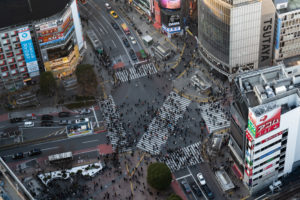
Shibuya
After getting a good look at Mt. Fuji, we will take the train to Tokyo and more specifically, Shibuya Station. Shibuya (渋谷) is one of the twenty-three city wards of Tokyo, but often refers to just the popular shopping and entertainment area found around Shibuya Station. In this regard, Shibuya is one of Tokyo’s most colorful and busy districts, packed with shopping, dining and nightclubs serving swarms of visitors that come to the district everyday. A prominent landmark of Shibuya is the large intersection in front of the station’s Hachiko Exit. The intersection is heavily decorated by neon advertisements and giant video screens and gets flooded by pedestrians each time the crossing light turns green, making it a popular photo spot.
Harajuku
A short train ride brings us to Harajuku. Harajuku (原宿) refers to the area around Tokyo’s Harajuku Station, which is between Shinjuku and Shibuya on the Yamanote Line. It is the center of Japan’s most extreme teenage cultures and fashion styles, but also offers shopping for adults and some historic sights.
The focal point of Harajuku’s teenage culture is Takeshita Dori (Takeshita Street) and its side streets, which are lined by many trendy shops, fashion boutiques, used clothes stores, crepe stands and fast food outlets geared towards the fashion and trend conscious teens.

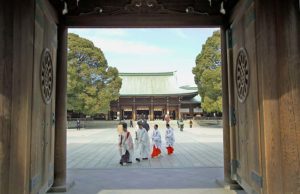
Meiji Shrine
Meiji Shrine (明治神宮, Meiji Jingū) is a shrine dedicated to the deified spirits of Emperor Meiji and his consort, Empress Shoken. Located just beside the JR Yamanote Line’s busy Harajuku Station, Meiji Shrine and the adjacent Yoyogi Park make up a large forested area within the densely built-up city. The spacious shrine grounds offer walking paths that are great for a relaxing stroll.
Shinjuku
Shinjuku (新宿) is one of the 23 city wards of Tokyo, but the name commonly refers to just the large entertainment, business and shopping area around Shinjuku Station.
Shinjuku Station is the world’s busiest railway station, handling more than two million passengers every day. It is served by about a dozen railway and subway lines, including the JR Yamanote Line. Shinjuku is also one of Tokyo’s major stops for long-distance highway buses. A large bus terminal, named Busta Shinjuku, is conveniently located on top of the railway station.
West of the station is Shinjuku’s skyscraper district, home to many of Tokyo’s tallest buildings, including several premier hotels and the twin towers of the Metropolitan Government Office, whose observation decks are open to the public for free.
Northeast of the station lies Kabukicho, Japan’s largest and wildest red light district, while department stores, subterranean malls and electronic shops surround Shinjuku Station on all four sides, including the redeveloped Southern Terrace.
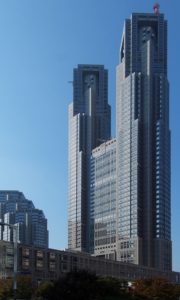
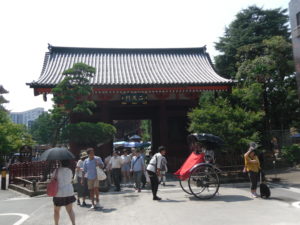
Asakusa
Another short train ride (or two) will bring us to Asakusa and our hotel. After we check in to our hotel, we’ll take a short break to freshen up and then away we go! Asakusa (浅草) is the center of Tokyo’s shitamachi (literally “low city”), one of Tokyo’s districts, where an atmosphere of the Tokyo of past decades survives.
Asakusa’s main attraction is Sensoji, a very popular Buddhist temple, built in the 7th century. The temple is approached via the Nakamise, a shopping street that has been providing temple visitors with a variety of traditional, local snacks and tourist souvenirs for centuries.
Asakusa can easily be explored on foot. Alternatively, you can consider a guided tour on a rickshaw (jinrikisha, literally “man powered vehicle”). A 30 minute tour for two persons costs around 9000 yen. Shorter and longer courses are also available.
ODaiba
For the last attraction of the day, we will be visiting ODaiba. Odaiba (お台場) is a popular shopping and entertainment district on a man made island in Tokyo Bay. It originated as a set of small man made fort islands (daiba literally means “fort”), which were built towards the end of the Edo Period (1603-1868) to protect Tokyo against possible attacks from the sea.
More than a century later, the small islands were joined into larger islands by massive landfills, and Tokyo began a spectacular development project aimed to turn the islands into a futuristic residential and business district.
It was not until the second half of the 1990s, when several hotels, shopping malls and the Yurikamome elevated train line were opened, that Odaiba developed into one of Tokyo’s most popular tourist attractions and date spots with a wide selection of shopping, dining and leisure options.
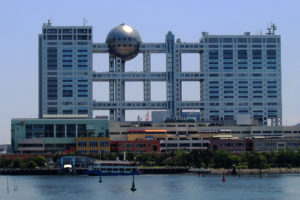
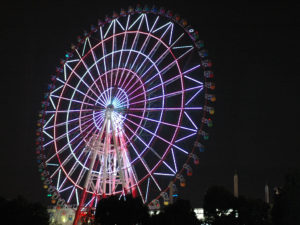
Attractions Possibilities for tokyo day 10
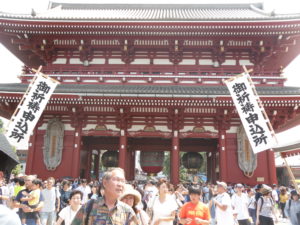
Kaminarimon
The Kaminarimon is the main entrance to Sensoji Temple, and its more formal name is Furaijinmon which literally means “the gate of the wind god and thunder god”. The characters for this name, 風雷神門, are written on the reverse side of the lantern. Originally built by military commander Taira no Kinmasa and dating back to 942 A.D., Kaminari Gate was later relocated to its current site.
It’s the gate’s centerpiece, a magnificent red lantern made by a Kyoto lantern maker, that first draws your eye. Measuring 3.9-meters high, 3.3-meters wide and weighing roughly 700 kilograms, the lantern’s grandeur is undeniable. Don’t miss the delicate dragon carvings adorning its base.
Flanking the lantern are two statues that give the gate its name; Japanese people commonly pay homage to these figures for peace, tranquility and abundant crops. The figure on the left is the God of Thunder, on the right, the Wind God. Guarding Sensoji from storm, flood and fire, both figures are said to be benevolent deities. Look for another two statues, the dragon-tailed gods Tenryu and Kinryu, who can be seen from behind after passing through the gate.
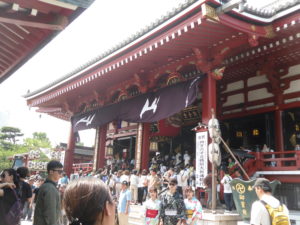
Sensoji Temple
Sensoji (浅草寺, also known as Asakusa Kannon Temple) is a Buddhist temple located in Asakusa. It is one of Tokyo’s most colorful and popular temples.
The legend says that in the year 628, two brothers fished a statue of Kannon, the goddess of mercy, out of the Sumida River, and even though they put the statue back into the river, it always returned to them. Consequently, Sensoji was built nearby for the goddess of Kannon. The temple was completed in 645, making it Tokyo’s oldest temple.
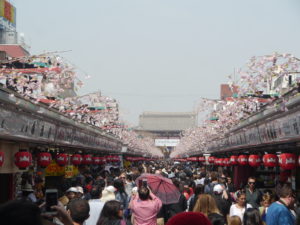
Nakamise Shopping District
The Nakamise shopping street stretches over approximately 250 meters from Kaminarimon to the main grounds of Sensoji Temple. It is lined by more than 50 shops, which offer local specialties and the usual array of tourist souvenirs.

Asakusa Shrine
Asakusa Shrine, also known as Sanja-sama, was built during the Edo Period and survived the air raids of 1945. The shrine’s festival, the Sanja Matsuri, is one of Tokyo’s most spectacular and popular. It is held every year on a weekend (Friday to Sunday) in mid May.
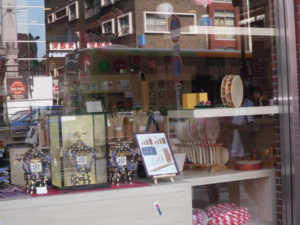
Miyamoto Taiko Store & Museum
Miyamoto Unosuke Shoten—a company that handles drums, portable shrines, and other festival-related items—opened the Drum Museum in 1988 to showcase drums collected from all over the world to the public. There are around 800 drums in this collection, ranging from giant to hand-held. These drums come from Asia, Africa, Europe, and the United States, and you can even try to play some of them. Drums are believed to connect people with each other and with the gods, so take the opportunity to connect during your visit.
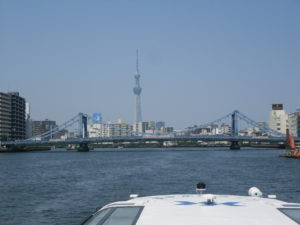
Sumida River Cruise
Did you know that Tokyo actually is a city of water? The southeastern part of the Japanese capital faces Tokyo Bay, while the Sumida River has acted as Tokyo’s gateway to the sea since ancient times. This access to the ocean has always attracted both people and business, and even today, you’ll spot many a ship sailing on the rivers and Tokyo Bay.
Among those ships are the so-called water buses, or suijo bus in Japanese. These unique boat taxis have gained popularity especially among tourists in recent years. These water buses do not only take you from one place to the other, however; they offer amazing views on the city of Tokyo, and in some cases even unique gourmet experiences.

